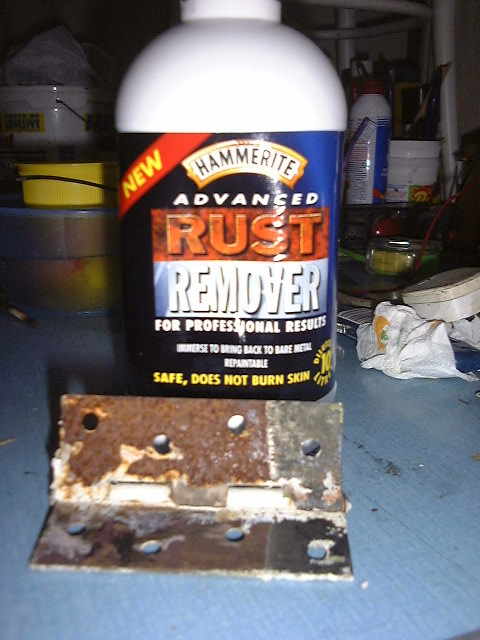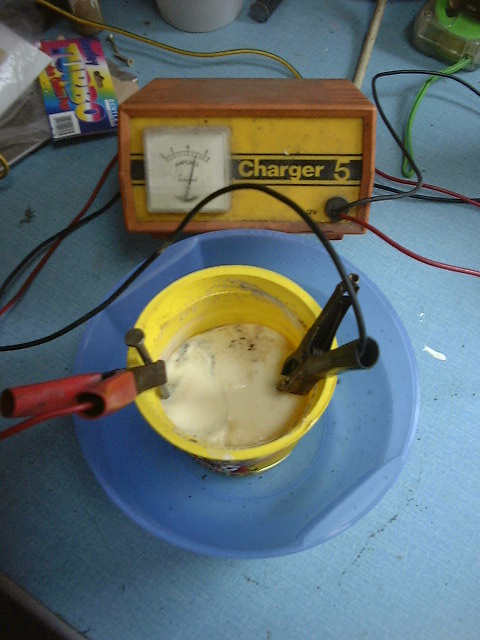 .
.Removing Rust by Electrolysis.
It's cheap, its safe (if you are careful!) and it works really well.
Electrolysis is one of those chemistry/physics procedures that has been around for donkeys years. As far as I can remember, and it's been a long time since I did this kind of stuff in college, it is the passing of an electric current through an electrolyte (current carrying medium, usually a fluid) causing all sorts of things to happen (can't remember any of them though!!), one of which we are going to use to our advantage against rust.
 .
.So I had a bit of a search on the web for "phosphoric acid" and "rust" and came upon the page below.
http://www.bhi.co.uk/hints/rust.htm
Had a read of the page and thought I'd give it a go. So with the aid of a pot noodle container ("seedy sanchez" flavour) a bit of copper wire, a plastic bowl, a battery charger, caustic soda and my girlfriend (who kindly bought the caustic soda for me while I was at work) I gave it a go. Figure 2 shows the end result.
 .
.
The top inch of the hinge was previously treated with the Hammerite rust remover to contrast the two methods. The whole hinge was then immersed in the caustic solution, a current was applied then the item removed and washed in cold water, the results seen were achieved in about 2 hours compared to nearly 24 for the Hammerite. Oh yea and as you can see the caustic cost Eur4. Figure 3 Shows the apparatus used.
Figure 3 .
.
Yep it's as simple as that, a nail (dont use a nail though, read point 5 at the bottom) for the Positive (anode, red) and the object to be cleaned as the Negative (cathode, black) connected to the black lead with a bit of copper wire. The solution is brown as I've used it and it is full of rust and the white bits are the paint from the hinge, did I mention it also strips paint!! Once you apply the current the whole thing starts to fizz instantly from the negative and then from the positive and a white foam develops on the top of the solution. Figure 4 is the setup (using two nails just as a demo) fizzing away

A couple of points on how I did this.
1) I used about 2 lid fulls of caustic soda in the solution.
2) The solution gets really hot so I put the "pot noodle" in another container with cold water in it to cool it down.
3) I used a 5 amp battery charger, every now and again it would switch itself off when it was drawing too much current. To get around this I raised the nail out of the solution till the meter was reading about 4 amps and the charger did not switch off.
4) I also did this on a larger scale, with a car wheel hub (the part with the bearings in it) after removing the bearings, in a large plastic storage crate with about 10 litres of water and most of the bottle of caustic.
5) The nail will get rusty and so conduct less electricity. For the large job I used a Stainless Steel Desert Spoon (thanks Ma!!) it did not rust and gave good conductivity so a tea spoon could be used for a small job.
6) A light working with a wire brush may be needed to knock off any rust scale and a rub with wet steel wool will give a brighter finish.
7) BE CAREFULL !!! It does give off some fumes, electricity is involved and the solution is caustic, it can burn. Take safety precautions, safety glasses, long sleeves, a pair of gloves, work in a well ventilated area, keep kids and pets out of the area.
8) Finally if you decide to give this a go, you do so at your own risk. Neither I nor the RD Club of Ireland take responsibility for any injury you may receive in carrying out any of the procedures illustrated on this page.